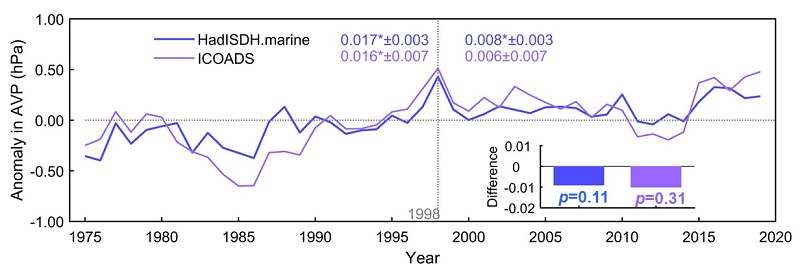Weakened increase in global near-surface water vapor pressure during the last 20 years
The increasing trend in global near-surface land and ocean actual water vapor pressure has weakened since the late 1990s, as shown in a study published in Geophysical Research Letters. This study was mainly led by Associate Prof. XU Wenfang from the South China Botanical Garden of the Chinese Academy of Sciences.
As one of the key components of the atmosphere, water vapor plays a crucial role in regulating the processes in the climate system. The near-surface actual water vapor pressure (AVP) strongly regulates surface vapor pressure deficit (VPD), i.e., the difference between saturation vapor pressure (SVP) and AVP. The increased VPD can increase atmospheric aridity and drought under global warming. As the air temperature rises, the SVP generally increases at a rate of 6%–7% K-1, as the atmospheric relative humidity changes little. Previous studies showed that near-surface AVP increases have stalled since around 2000. However, the exact causes leading to the weakened increase of AVP are still not well understood.
Using five observational datasets, the researchers found that an increasing trend of near-surface AVP over land and ocean was significant from 1975 to 1998, while such an increasing trend in AVP subsequently weakened from 1999 to 2019. Such weakened AVP is associated with a slowdown in oceanic evaporation (more important) and land surface evapotranspiration, which is influenced by sea and land surface temperature, respectively.
The weakened increase in the AVP trend further amplified the near-surface VPD increase since the end of the 1990s. The increased VPD will limit the plant transpiration through closing stomata, which in turn increases atmospheric demand for water vapor and, thus, atmospheric aridity and drought over land.
This study emphasizes the rate of AVP increase plays a more important role than the SVP increase for the VPD increase.
https://doi.org/10.1029/2023GL107909

